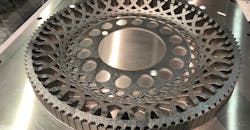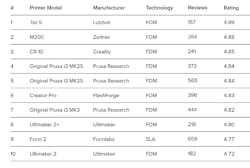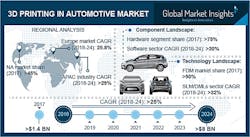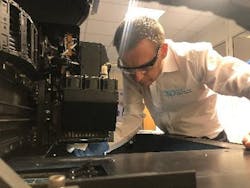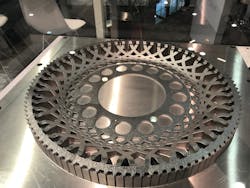With so many developments in the additive manufacturing world to follow, I decided to use this article to compile some representative news items and reports. Taken together, they’ll provide you with greater insight into the most noteworthy 3D printing trends. The following features:
- The latest edition of the 3D Hubs Online Manufacturing Trends report
- Global Markets Insights’ report on 3D printing in the automotive industry
- The importance of partnerships
- New programs to stimulate 3D printing growth
3D Hubs Report
The Online Manufacturing Trends report by 3D Hubs for Q4 2018 launched in October. Here are some highlights:
- In the space of Desktop 3D Printing, Lulzbot Taz 5 overtook Zortrax M200 as the Highest Rated Desktop 3D Printer, while Formlabs Form 2 and the printers of Prusa Research continued to dominate the Most Used Desktop 3D Printers category.
- The HP Jet Fusion 3D 4200 continues to reign supreme in the Industrial 3D printing category, receiving an almost flawless score of 4.91 out of 5.00, while taking the No. 1 spot as the Most Used Industrial 3D Printer, producing over 6,400 parts.
- Two large-format SLA/DLP systems climbed to the top of the Highest Rated Industrial 3D Printers charts: UnionTech Lite 600 and Shining 3D iSLA-650 Pro. For the first time, three Material Jetting systems (PolyJet) by Stratasys entered the charts of Most Used Industrial 3D Printers, producing 2,500 parts in total. This shows a need in the market for high-accuracy parts with an injection-molding-like finish by pro users.
- The same trend also appeared in the Most Used 3D Printing Materials category, where the Standard and Durable resin for both SLA/DLP and Material Jetting increased their combined market share considerably, even surpassing the share of SLS nylon.
- In the CNC machining space, Aluminum 6061 continues to be by far the most used material. There was a significant increase in the combined market share of the “Other” materials, showing the versatility of the CNC process to produce parts from materials that fit the needs of a particular niche application.
- For the first time, Geographic distribution of CNC users was introduced in this edition of the Trends report, giving room for comparisons with the 3D printing market.
The Digital Manufacturing Trends are available for download here.
Highest ranked plastic extrusion printer among 3D Hubs community.
Partnerships
There seems to be more partnerships and consortiums than ever. For example, GKN Sinter Metals, a world-leading manufacturer in metal powder, is teaming up with HP and Volkswagen. HP has really hit the ground running with its plastic printer and is making waves again with the new Metal Jet that claims to be up to 50 times more productive than other processes. This mean the industry might go through a lot more powder, and GKN is already prepared. GKN has the size and scope to make custom small batches, and is making several high-productivity metal blends from titanium to steels in preparation for 3D printing to move from prototyping to production. This is important for several reasons:
- HP has really pushed into the 3D printing market, and with a new metal printer it is keeping competitors on their toes.
- Partners and collaboration are essential to gaining confidence in 3D printing technology that will accelerate growth. Finding one of the biggest car companies, and powder producers in the world is a great start.
- The supply chain will be increasingly important as powder processes increase due to confidence and design validity in 3D printing technology. HP seems they have partnered with everyone in the chain other than the ore companies and the end-users. This will give them smooth operation and a great deal of potential data they could use for better decision-making, as well as for getting into other verticals and data as a service.
Global Market Insights
But, don’t think the Automotive market is all metal 3D printing. According to research from Global Market Insights, Inc, plastic extrusion 3D printing technology held over 50% market share in the 3D printing in automotive market in 2017. This growth is credited to technological advancements in composite materials used across plastic extrusion processes and its ability to print larger components.
One image from the 280-page Global Market Insight report.
Overall, the increased use of 3D printing is also largely due to the decrease in cost of the printers, and advancements in the software’s capabilities to add features that make 3D printers easy to use. There is growing need for developing complex and high-quality components while keeping the manufacturing costs low, which is another factor driving the demand for the 3D printing solutions in the automotive sector.
According to a Global Market Insights report, “the 3D Printing in Automotive Market to cross USD 8 billion by 2024. While prototyping is expected to account for approximately 60% of the market share in the 3D printing in automotive market…it also reduces the tooling costs as it allows manufacturers to use the same tooling equipment to develop a wide variety of models.”
Projects to Accelerate 3D printing
It will be important to watch countries that are encouraging 3D printing with support and investments. Most developed nations and large companies have some form of 3D printing outreach.
North America holds the major share in the 3D printing in automotive market. It held more than 40% share of the total revenue in 2017, according to the Global Markets Insight report. The presence of major market players in the region, such as Stratasys and 3D Systems, is a primary factor supporting the market growth.
Furthermore, supportive government initiatives will also foster the market growth. For instance, the U.S. government is constantly working with various private institutions and academic establishments to promote the use of 3D printing technologies.
But companies are investing in multiple countries. HP has invested in programs in China and India. In the Global Market Insight forecast, the Asia Pacific 3D printing in the automotive market is expected to grow substantially at a CAGR of over 30% during the forecast timespan. The industrialized countries, as well as emerging nations in the Asian region, have introduced numerous initiatives to strengthen the productivity and competitiveness across the automotive manufacturing sector. In addition, countries including Singapore and China have allocated millions of dollars to commercialize the technology.
In the UK the first Stratasys Authorised Training Center in the UK is now open and operated by Stratasys Partner, Tri-Tech 3D, at its offices in Stoke. The Tri-Tech 3D Print Academy in the UK offers training for users of Stratasys FDM and PolyJet 3D printing technologies. The goal is to support users in maximizing their investment in 3D printing and help them avoid expenses through production errors and material wastage.
Centers like this will determine how far companies invest into this type of outreach, but there are already plans to add authorized training centres in UK, Scandinavia, and Benelux.
In addition, Canada launched the Industrial Research Assistance Program (IRAP) to drive the use of 3D printing among small- and medium-sized organizations. This is encouraging organizations to adopt the cutting-edge technology to reduce the cost of operation and increase the productivity.
According to the book The Pan-Industrial Revolution, author Richard D’Aveni suggests 3D printing will bring a global shift. Asian countries will start acquiring advanced flexible manufacturing in 3D printing and automation, which will cause an industrial revolution. There are already large programs being launched that are looking to make this happen, and some that are already happening under the radar.
For example, D’Aveni did some investigating and “found a supplier known as Lite-On had been using AM [additive manufacturing] to build antennas for HTC, the Taiwan-based manufacturer of Android and Windows based smartphones. Armed with an array of 3D printers built by a New Mexico company called Optomec, which were specifically equipped for producing electronics, Lite-On had been turning out some [15] million antennas per year.”
3D printing has already been changing the way we think about manufacturing. GE has been widely known for its LEAP engine and fuel nozzle, and it hsn’t stopped. This year at IMTS, GE Additive talked about targeting more than 100 components for 3D printing optimization. Some parts are brackets for the GEnX, but GE Additive have just taken that feat to a new level.
GE Reports
Over the last 10 months, GE Additive has developed a new process to mass-print a much larger part for a version of the GEnx jet engine that powers the latest generation of Boeing 747s. To do so, the team also had to “production-proof” the new line of printers for the part.
This is the first time GE has designed a mass-production process for a line of its own printers made by Concept Laser, a German engineering company it acquired in 2016. “Minor tweaks here and there are okay in the development phase, but when you get into production, everything has to be locked down,” says Danny Brandel, a lead manufacturing engineer at the ATC and a member of the team. He says this is especially important in aviation because of tight FAA regulations.
Not everything is in the aerospace industry, either. GE Additive has targeted more than 250 components in the locomotive industry. It has already optimized a 700 mm overhead valve gear from a locomotive on display at IMTS. This part reduced a 100 lb part to a 12 lb. Keeping up with the 3D printing industry can be difficult as it continues to innovate and disrupt.
GE Aviation plans to begin mass-producing the GEnx parts this month at its factory in Auburn, Alabama. “The reason we did this project was because it represented several firsts for us,” says Eric Gatlin, a general manager for GE Aviation’s additive integrated product team. “It’s our first program we certified on a Concept Laser machine, and it’s also the first project we’ve taken from design to production in less than 10 months.”
This is just a small taste of the 3D printing news to cover, and there’s new innovations and disruptions every day in many verticals. It will not only be big companies that leverage intellectual property, technology, and supply chain, but companies that find a way to use the data as a service. 3D printing is big, and some printers are starting to have sensors and feedback loops. With some of the mass of data being collected, companies with large IoT dashboards platforms will be able to work with 3D printers and other connected equipment to further streamline the manufacturing process.
This is already being seen in the fashion world. Some sellers have a connected platform to gauge what garments to scale up and down in real-time based on sales and fashion trends. In manufacturing this will be that same for products, but it goes further. Bringing Software-as-a-Service (SaaS) can scale production, suggest maintenance schedules to reduce downtime, and more. The next step will be large dashboard platforms to monetize the data itself for anything from new products, scaling the company, or pointing out potential partners.
It’s an interesting revolution that’s happening; the companies that partner up will be stronger. Perhaps the biggest change is the move from tangible to intangible assets as industry move further into digital manufacturing. The company that adopts technology early, promotes flexibility, accelerates the validity of concepts, and finds the best way to monetize the data they and their partners create will stay on the leading edge on the industry.
